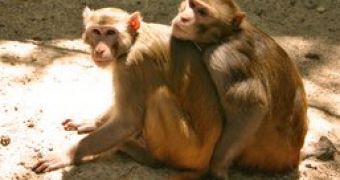Some anthropologists name the human species "the beautiful ape" or "the beautiful monkey".
Looking at some of our counterparts, I seriously doubt this, but what I really do not doubt is that we are a type of monkey. And the first monkey whose genome has been sequenced, the rhesus macaque, confirms it: we share 93 % of our genes.
This primate could be the most common employed in lab researches, due to many of their characteristics. They are one of the most adaptable monkey species in the world, able to live from the deserts of Afghanistan and northern India till the cool mountains of southern China and are easy to keep in laboratories.
These monkeys gave their name to the blood Rh factor, found in 1937 after researches conducted on them. This is also the first monkey species to have traveled into space and to be cloned.
And many past and current researches on brain activity, drug addiction and HIV, primate-related, are made on these monkeys. "The sequence of the rhesus macaque's genome will be a powerful tool for research with the monkeys aimed at understanding human biology," said consortium leader Richard Gibbs, director of the Baylor College of Medicine's Human Genome Sequencing Center in Houston.
"Right now if you perform an experiment on a person, there's no way that you would think that all people are the same, when it comes to a response to a drug or behavior or anything," said Gibbs. "Being able to understand them on a genetic level will help explain variation in their responses and will allow for smarter experiments that make us more clever at deciphering results."
The new investigation, carried on by an international team of 170 researchers, as previously said, found about 93 % of common DNA between humans and the rhesus macaques while previous investigations discovered in the case of humans and chimpanzees a 98 - 99 % value. "The fact that rhesus monkeys are further away from humans in evolution will help illuminate what makes humans different from other apes in ways that chimps, which are so closely related to us, could not," Gibbs said.
Macaques ancestors are believed to have split off from the common branch that led to humans about 25 million years ago, while chimpanzees about 4 million years ago. The team detected about 200 genes that seem to be crucial players "in defining the shapes of species, in what makes the primates different from us and each other," Gibbs said.
Most of them are implied in hair formation, sperm-egg fusion, immune activity and cell membrane proteins.
The scientists were amazed by the monkey's X chromosome peculiar traits: it displayed a high number of replications in the nearby DNA areas.
The same puzzling rearrangements have been noted in the human lineage's X chromosome after the split off of the chimpanzee, delivering "us new evidence of the unusual role of this sex chromosome in primate evolution," said researcher Aleks Milosavljevic at the Baylor College of Medicine.
The team also detected centromeres, DNA stretches that hold together the two separate DNA branches that make up a chromosome, working somewhat like the center of an X.
9 of the 22 centromeres of the macaques have relocated themselves on their chromosomes in the last 25 million years, after splitting off the common trunk. "If we can get the genome sequences of one representative from each primate lineage, we could reconstitute the ancestral primate genome-what the genome of our common ancestor some 40 to 50 million years ago looked like," said physician scientist Ajit Varki at the University of California at San Diego, who was involved in the chimpanzee genome sequencing project.

 14 DAY TRIAL //
14 DAY TRIAL //